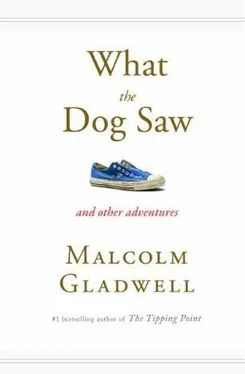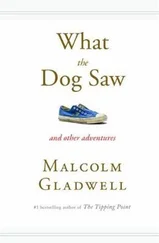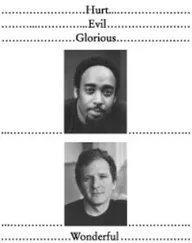“Well,” I said, “I would look at the two and decide what I was best at, and then go to my boss and say, ‘It’s better that I do one well than both poorly,’ and we’d figure out who else could do the other task.”
Menkes immediately seized on a telling detail in my answer. I was interested in what job I would do best. But isn’t the key issue what job the company most needed to have done? With that comment, I had revealed something valuable: that in a time of work-related crisis I start from a self-centered consideration. “Perhaps you are a bit of a solo practitioner,” Menkes said diplomatically. “That’s an essential bit of information.”
Menkes deliberately wasn’t drawing any broad conclusions. If we are not people who are shy or talkative or outspoken but people who are shy in some contexts, talkative in other situations, and outspoken in still other areas, then what it means to know someone is to catalog and appreciate all those variations. Menkes was trying to begin that process of cataloging. This interviewing technique is known as structured interviewing, and in studies by industrial psychologists it has been shown to be the only kind of interviewing that has any success at all in predicting performance in the workplace. In the structured interviews, the format is fairly rigid. Each applicant is treated in precisely the same manner. The questions are scripted. The interviewers are carefully trained, and each applicant is rated on a series of predetermined scales.
What is interesting about the structured interview is how narrow its objectives are. When I interviewed Nolan Myers I was groping for some kind of global sense of who he was; Menkes seemed entirely uninterested in arriving at that same general sense of me—he seemed to realize how foolish that expectation was for an hour-long interview. The structured interview works precisely because it isn’t really an interview; it isn’t about getting to know someone, in a traditional sense. It’s as much concerned with rejecting information as it is with collecting it.
Not surprisingly, interview specialists have found it extraordinarily difficult to persuade most employers to adopt the structured interview. It just doesn’t feel right. For most of us, hiring someone is essentially a romantic process, in which the job interview functions as a desexualized version of a date. We are looking for someone with whom we have a certain chemistry, even if the coupling that results ends in tears and the pursuer and the pursued turn out to have nothing in common. We want the unlimited promise of a love affair. The structured interview, by contrast, seems to offer only the dry logic and practicality of an arranged marriage.
Nolan Myers agonized over which job to take. He spent half an hour on the phone with Steve Ballmer, and Ballmer was very persuasive. “He gave me very, very good advice,” Myers says of his conversations with the Microsoft CEO. “He felt that I should go to the place that excited me the most and that I thought would be best for my career. He offered to be my mentor.” Myers says he talked to his parents every day about what to do. In February, he flew out to California and spent a Saturday going from one Tellme executive to another, asking and answering questions. “Basically, I had three things I was looking for. One was long-term goals for the company. Where did they see themselves in five years? Second, what position would I be playing in the company?” He stopped and burst out laughing. “And I forget what the third one is.” In March, Myers committed to Tellme.
Will Nolan Myers succeed at Tellme? I think so, although I honestly have no idea. It’s a harder question to answer now than it would have been thirty or forty years ago. If this were 1965, Nolan Myers would have gone to work at IBM and worn a blue suit and sat in a small office and kept his head down, and the particulars of his personality would not have mattered so much. It was not so important that IBM understood who you were before it hired you, because you understood what IBM was. If you walked through the door at Armonk or at a branch office in Illinois, you knew what you had to be and how you were supposed to act. But to walk through the soaring, open offices of Tellme, with the bunk beds over the desks, is to be struck by how much more demanding the culture of Silicon Valley is. Nolan Myers will not be provided with a social script, that blue suit, and organization chart. Tellme, like any technology startup these days, wants its employees to be part of a fluid team, to be flexible and innovative, to work with shifting groups in the absence of hierarchy and bureaucracy, and in that environment, where the workplace doubles as the rec room, the particulars of your personality matter a great deal.
This is part of the new economy’s appeal, because Tellme’s soaring warehouse is a more productive and enjoyable place to work than the little office boxes of the old IBM . But the danger here is that we will be led astray in judging these newly important particulars of character. If we let personability—some indefinable, prerational intuition, magnified by the Fundamental Attribution Error—bias the hiring process today, then all we will have done is replace the old-boy network, where you hired your nephew, with the new-boy network, where you hire whoever impressed you most when you shook his hand. Social progress, unless we’re careful, can merely be the means by which we replace the obviously arbitrary with the not so obviously arbitrary.
Myers has spent much of the past year helping to teach Introduction to Computer Science. He realized, he says, that one of the reasons that students were taking the course was that they wanted to get jobs in the software industry. “I decided that, having gone through all this interviewing, I had developed some expertise, and I would like to share that. There is a real skill and art in presenting yourself to potential employers. And so what we did in this class was talk about the kinds of things that employers are looking for—what are they looking for in terms of personality. One of the most important things is that you have to come across as being confident in what you are doing and in who you are. How do you do that? Speak clearly and smile.” As he said that, Nolan Myers smiled. “For a lot of people, that’s a very hard skill to learn. But for some reason I seem to understand it intuitively.”
May 29, 2000
Troublemakers
WHAT PIT BULLS CAN TEACH US ABOUT CRIME
One sunny winter afternoon, Guy Clairoux picked up his two-and-a-half-year-old son, Jayden, from day care and walked him back to their house in the west end of Ottawa, Ontario. They were almost home. Jayden was straggling behind, and, as his father’s back was turned, a pit bull jumped over a backyard fence and lunged at Jayden. “The dog had his head in its mouth and started to do this shake,” Clairoux’s wife, JoAnn Hartley, said later. As she watched in horror, two more pit bulls jumped over the fence, joining in the assault. She and Clairoux came running, and he punched the first of the dogs in the head, until it dropped Jayden, and then he threw the boy toward his mother. Hartley fell on her son, protecting him with her body. “JoAnn!” Clairoux cried out, as all three dogs descended on his wife. “Cover your neck, cover your neck.” A neighbor, sitting by her window, screamed for help. Her partner and a friend, Mario Gauthier, ran outside. A neighborhood boy grabbed his hockey stick and threw it to Gauthier. He began hitting one of the dogs over the head, until the stick broke. “They wouldn’t stop,” Gauthier said. “As soon as you’d stop, they’d attack again. I’ve never seen a dog go so crazy. They were like Tasmanian devils.” The police came. The dogs were pulled away, and the Clairouxes and one of the rescuers were taken to the hospital. Five days later, the Ontario legislature banned the ownership of pit bulls. “Just as we wouldn’t let a great white shark in a swimming pool,” the province’s attorney general, Michael Bryant, had said, “maybe we shouldn’t have these animals on the civilized streets.”
Читать дальше











